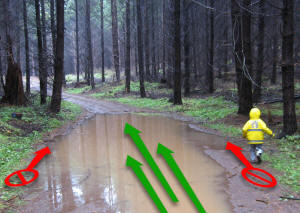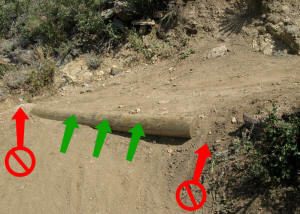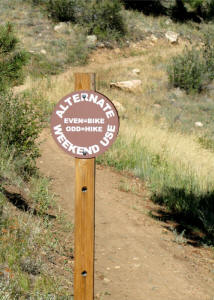How to Ride Green
10 Tips for Riding Responsibly
original article by Kovas Lapsys on August 28, 2008
As mountain bikers, we often pride ourselves as being ‘green’ outdoors-folks; individuals who would rather spend a day outside sweating and grunting up a mountain, than sitting inside and watching the PGA Tour. We tend to be more of the trash-recycling, organic Whole-Foods eating, micro-brew drinking, free-trade coffee sipping and earth-loving crowd. Yet do we practice our progressive “green” habits on the trail as well? As we mount our aluminum, carbon fiber and titanium beasts of speed, we often forget that the trails we ride on are actually fragile living beings. They’re comprised of roots that grow, layers of rock and mud that constantly shift, and living plants and organisms that anchor their sides. A trail left unridden will actually grow-over and disappear given enough time. But abusing a trail will actually destroy its somewhat fragile structure and ‘kill’ it even faster.
So with that being said, when you’re out ripping-it-up on your favorite trail, please keep these ‘green’ riding tips in mind.
1) Stay on the trail
Sure, that tree stump or natural rock ramp a couple feet off the trail might be all too tempting for a quick jump or bunny-hop, but the fact is that it is not part of your trail. Where one goes, others are sure to follow… As your tread marks are much more visible on the softer off-trail, other riders are going to follow your fresh path to that ‘hidden’ jump… Before you know it, your ‘little secret’ is now everyone’s favorite hop-spot and the once narrow groomed trail is now a sprawling free-for-all playground.
2) Ride through puddles, not around them!
ATTENTION: Most trails in Texas should be completely avoided until they have dried. The majority of trails in Texas are easily damaged by riding when they are wet and muddy. Be responsible and let them dry out.
Riding around a puddle only compacts the ground surrounding
the puddle, leveling it lower and allowing the puddle to grow. I’m sure
we’ve all seen it, trails that pinch and bloat where wet-sections are prominent. Seems like nobody wants to ride their $2000 mountain bike through
a little mud… c’mon folks, it’s a knobby bike, not a road bike! Trust me
– your bike’s bearings and seals can take much more grit than a few calm
puddles can dish out. Fact is, the center of the puddle has the most compacted
base. That is why the puddle is not being absorbed by the trail. By riding
around the circumference, you are actually compressing the softer, more
fragile edge of the puddle, which will inevitably either compact, allowing
the puddle to grow and the trail to bloat, or it will contribute to overall
trail erosion. The best thing you can do for the trail is ride right smack-dab
through the center. Eventually the puddle will dry up, but the damage to
trails from poor puddle-riding is irreversible. So when you see that puddle
up ahead, get some speed, coast through the center and don’t forget to keep
your mouth shut. Or if you simply don’t want to get a little dirty… God
forbid… dismount your bike and walk across.
prominent. Seems like nobody wants to ride their $2000 mountain bike through
a little mud… c’mon folks, it’s a knobby bike, not a road bike! Trust me
– your bike’s bearings and seals can take much more grit than a few calm
puddles can dish out. Fact is, the center of the puddle has the most compacted
base. That is why the puddle is not being absorbed by the trail. By riding
around the circumference, you are actually compressing the softer, more
fragile edge of the puddle, which will inevitably either compact, allowing
the puddle to grow and the trail to bloat, or it will contribute to overall
trail erosion. The best thing you can do for the trail is ride right smack-dab
through the center. Eventually the puddle will dry up, but the damage to
trails from poor puddle-riding is irreversible. So when you see that puddle
up ahead, get some speed, coast through the center and don’t forget to keep
your mouth shut. Or if you simply don’t want to get a little dirty… God
forbid… dismount your bike and walk across.
3) Stay in-line, No Shortcuts
Shortcutting causes erosion. Trails are built and designed to take a beating - either by foot, hoof or tire. Everything else should be considered fragile ecosystem. 2 feet off the trail is still off-the-trail. If a log, tree, boulder or other obstacle blocks your trail, your only options should be to bunny-hop over or pause your ride, dismount your bike, and carry your bike over the obstacle before continuing. Just like puddles, a trail will grow and bloat when riders take short cuts.
4) STOP skidding
Nothing says, “I don’t know how to ride my bike,” than a 6-foot-long skid with dust and gravel shooting all over the place. Yes, we’ve all been genetically pre-programmed from our first coaster-brake BMX bikes to lock up that rear wheel and throw our bike into a mean skid. But we’re not in 4th grade anymore. Your bike now has two brakes, one in the front and one in the rear (Your front wheel actually provides more stopping power and will never skid). Skidding is by no means the best way to stop. It destroys the rubber on your tire, drastically reduces control of your bicycle, and worst of all – creates trail stutter bumps and gross amounts of erosion on the trail. Skids are more responsible for trail damage than nearly any other poor-riding habit. Read your trail and anticipate your stops ahead of time. When you do have to make that emergency ‘oh-Sh#!’ stop, throw your bum far behind your seat, crouch low in the cockpit, and give both front and rear levers a squeeze. If you find yourself skidding constantly, you are simply going too fast. Slow down! Keep your trails like your shorts, skid-mark free.
5) Let it rain
If the forecast calls for rain, stay home and mow your lawn. Don’t ride a trail when it’s raining. If you’re on a trail and it starts to rain, make your way home. Save the ride for a dryer day. Riding in wet weather more than doubles your impact and ‘foot-print’ on the trail. The softer surface will cause your knobby tires to leave deeper tread marks and also carry more of the trail away with them. On singletrack, your tires will actually push the trail (mud, dirt, gravel, etc) far to the sides, eventually gouging and deepening the already narrow trail, rendering it unrideable in the future. Riding in the wet is not safe for you either - No matter how sticky your tire rubber may be, its no match for slime-slick roots, wet stones and sloppy mud. Remember, a rainy day is a good thing for your trail. Rain helps smooth loose areas, compact accumulated dust and sand, and gives roots, plants and other live trail anchors some well-deserved refreshment.
6) Switchbacks and logs
Erosion, erosion, erosion. If you ride your switchbacks
wide, you’re going to cause erosion. Ride them tight, and you’re going to
cause erosion. Skid into a switchback, and
 you’re
going to cause erosion! When approaching a switchback. Always keep yourself
centered. If the switchback has a retaining log, ride over the middle of
it. The log is there to keep the switchback (and the trail) in place. By
riding outside the log, you are actually slowly dislodging it. Think of
the log as a technical-treat rather than a trail obstacle. Sure, going over
the center of it may be more exhausting and straining than going around
the outside or inside, but hey, you’re riding for some exercise, right?
Too tired to ride the center – remember, the PGA tour and your Lay-Z-Boy
are still at home waiting for you.
you’re
going to cause erosion! When approaching a switchback. Always keep yourself
centered. If the switchback has a retaining log, ride over the middle of
it. The log is there to keep the switchback (and the trail) in place. By
riding outside the log, you are actually slowly dislodging it. Think of
the log as a technical-treat rather than a trail obstacle. Sure, going over
the center of it may be more exhausting and straining than going around
the outside or inside, but hey, you’re riding for some exercise, right?
Too tired to ride the center – remember, the PGA tour and your Lay-Z-Boy
are still at home waiting for you.
7) Obey all trail signs
If a trail is closed, don’t ride it. Most likely a closed
trail either requires significant maintenance, is restricted to slower-traffic (hikers), or it was simply not designed
to handle mountain bikes. You may get away with it once or twice, but eventually
a ranger will ticket you. In some states, a law enforcement ranger can legally
confiscate your bike as evidence! But even worse than any ticket or ride
to the impound lot is that by disregarding trail postings, you give the
rest of us mountain bikers a bad name. Hikers, equestrians, birdwatchers,
etc – all have more powerful lobbying groups than mountain bikers. Legally
it is much more difficult to have a trail re-opened for mountain bike use,
than it is to have one restricted. Anger one too many trail users, and you’ll
see your trail closed. While on your bike you are most likely faster than
any other trail user, and you are more likely to surprise, spook, and unknowingly
anger others sharing your path. Always pull aside for hikers and step off
the trail completely for horses. Announce yourself clearly as you pass,
and avoid kicking up unnecessary dust (See Tip #4).
is restricted to slower-traffic (hikers), or it was simply not designed
to handle mountain bikes. You may get away with it once or twice, but eventually
a ranger will ticket you. In some states, a law enforcement ranger can legally
confiscate your bike as evidence! But even worse than any ticket or ride
to the impound lot is that by disregarding trail postings, you give the
rest of us mountain bikers a bad name. Hikers, equestrians, birdwatchers,
etc – all have more powerful lobbying groups than mountain bikers. Legally
it is much more difficult to have a trail re-opened for mountain bike use,
than it is to have one restricted. Anger one too many trail users, and you’ll
see your trail closed. While on your bike you are most likely faster than
any other trail user, and you are more likely to surprise, spook, and unknowingly
anger others sharing your path. Always pull aside for hikers and step off
the trail completely for horses. Announce yourself clearly as you pass,
and avoid kicking up unnecessary dust (See Tip #4).
8) Mix it up
Don’t ride the same trail every weekend. Give your favorite trail a chance to revive. I’m sure you have a trail that you know like the back of your hand, we all do. With a trail that you know well, you’re more likely to pedal faster, brake harder, and accelerate stronger. All these factors lead to more strain and stress on the trail surface. Rather, ride a variety of trails throughout your season. By doing so, you not only spread your individual rider footprint, but you will also hone your trail skills as well.
9) Join IMBA or your local trail organization
Mountain biking is for the most part a free activity, yet the work that goes into maintaining and opening trails is anything but. If you can’t give up your own time to volunteer on trail work, why not push a few dollars over to those who can. Donate every year to your local trail organization, open-space park, or forest preserve. Join IMBA (International Mountain Bike Association), the sole organization that represents us in DC, lobbies for riders’ rights, works to open trails and to keep our sport free. It’s only a few dollars to join and you get some cool stickers and swag, as well as the piece of mind that you’re doing your part.
10) Share the knowledge - Be a good ambassador
If you see another rider ruining your trail, you have full right to speak your mind – after all, it’s your trail too. Be firm, you’re in the right. Be polite, but if that doesn’t work, a little passive comment might do the trick. If someone is riding their bike off the trail, you can always say, “Hey bud, you look lost, the trail is right over here…”
Riding ‘green’ is every rider’s responsibility. A few small changes to your riding style can do great things for the health of your favorite trails. Share these tips with your riding buddies, and lastly - always remember to practice what you preach.
- copied from MTO Bikes' website - used with permission